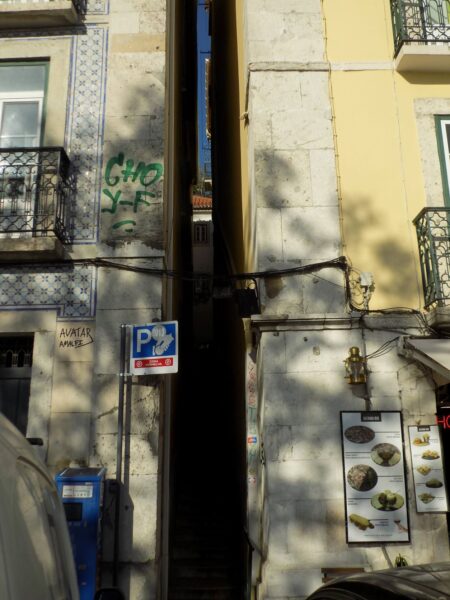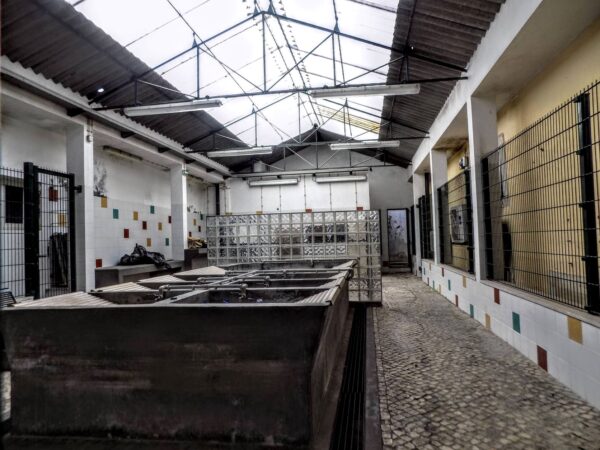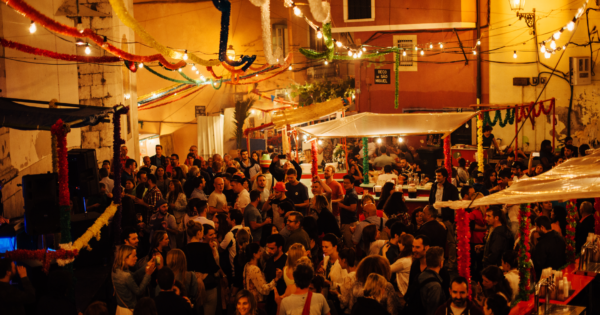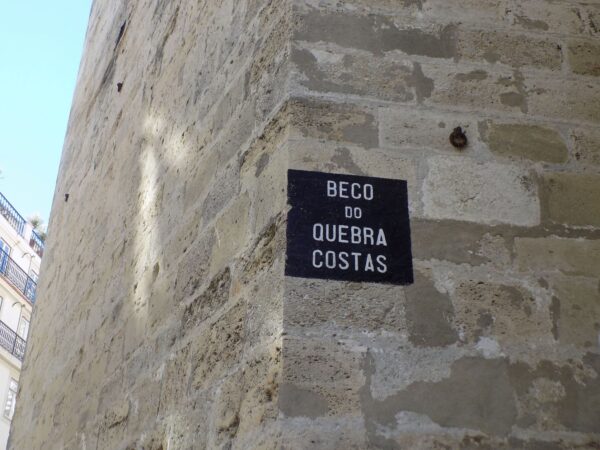My Secret Place.
One of the real pleasures of walking through Lisboa with Ana is that, by virtue of the depth of her knowledge of the city, she’ll lead me to and stop at places I wouldn’t have otherwise noticed. The reason we were walking up the hills of Alfama was that I’d told her I wanted to go to the Mosteiro de São Vicente da Fora. (I might or might not have told her that I wanted to see the Seashell Gallery there.) To reach there, we’d have to pass the Miradouro da Santa Luzia a point I’d visited to see the comic strip mural. You might recognize this view of the monastery (from one I posted earlier) from the photo she took of me with “the bag”.

However, on our way up the hill we paused at three not really secret spots but certainly places I would have blown past in my typical single minded pursuit of reaching a particular place. You should keep in mind that a city’s personality is defined not only by its geography, geology, history, culture, and population but also by its quirks and oddities so while on one level they might not appear to be a big deal, on another level, they are. It’s some of these latter elements that Ana pointed out to me on this day.
Let’s start with what might or might not be the narrowest street in Lisboa:.

It’s both steep and narrow as you can see. She also took me to another street that makes the same claim. Like this one, it has a steep ascent (or descent depending on your point of view). To my untrained eyes, the other – that we also viewed from the bottom – might be as narrow at the bottom but it looked wider at the top. Since I had a winner in mind, I didn’t take a photo of the also ran. But, if you’re interested, I think this is it.
The second spot actually has some historical and cultural significance.

This is a lavanderia or laundry – a service that’s particularly appropriate to this neighborhood since the etymological source for Alfama is generally believed to be from the Arabic Al-hamma meaning the hot-spring, bath, or fountain.
Few, if any, of the small old apartments in Alfama have the space for a washing machine so small neighborhoods within the larger area offer these public spaces where residents can bring their clothes and linens to hand wash them. Although it wasn’t in use when we walked by, Ana explained that they are more or less free to the residents. I write more or less free because typically, there’s someone who controls access – usually an older woman who can share all the neighborhood gossip – and it’s expected that each user will leave a few coins. Some of them will be used to compensate the gatekeeper and the rest will be used to purchase some of the neighborhood’s decorations for the Casamentos de Santo António or feast of Santo António, who is Lisbon’s patron saint, on his festival day in mid June.
(Although he’s known as Saint Anthony of Padua, this patron saint of lost things as well as love and marriage was born Fernando Martins de Bulhões to a wealthy family in Lisboa in 1195 which is why the city claims him as its own. One of the major events on his festival day is a collective marriage ceremony held simultaneously for several couples in the Sé de Lisboa.
The Festival of Saint Anthony is a major party and celebratory day and night in Lisboa. If you ever take part, be prepared to eat lots of grilled sardines because they’re so common that some people refer to the day as Festa da sardinhas. During the day you can also watch the parade down the Avenida da Liberdade in which different floats, dancers, and musicians competitively represent each neighborhood in hopes that they will be declared vencedor das marchas populares or winner of the Popular Marches.
After nightfall, the crowds are likely to look like this photo taken from Prime Lisbon.

Ana described some of her experiences to me and I can only say that if you attend be prepared for crowds so dense you can pass out drunk and nearly remain standing. You should also be prepared to go all night long eating grilled sardines on country bread and drinking your favorite spirits. As the website The CultureTrip writes,
The grills and picnic tables appear during the day, so if you’re afraid of crowds, head out early to snack on sardines and caldo verde (kale soup), and to hear some traditional music while sitting comfortably. Once the sun goes down, however, there won’t be anywhere to sit and you’ll be pushing your way through the crowded streets, especially in Graça, Alfama, and Bica, three of the more popular neighborhoods.)
The last of the three spots would be the

Beco do Quebra Costas. This translates as Backbreaker’s Alley. According to Ana, this lovely sobriquet arose from the profusion of bars at the top of the alley that led to uncounted drunken falls down its steep uneven steps. Truth? Legend? Who knows. Definitely a fun bit of trivia, though.
It’s okay, I’ll probably survive it.
By the time we reached the Miradouro, we’d covered about half the linear distance and, although we’d completed most of the ascent to Saint Vincent’s Church and Monastery, we’d still have to rise again. Just outside the church, Ana got into an animated discussion with a tuk-tuk driver who I think was soliciting business. Tourist tuk-tuks are ubiquitous around Lisboa and she told me that there’s a strained relationship between licensed tour guides and these drivers.
Tour guides such as Ana are subject to strict education and testing before they can obtain their licenses. The tuk-tuks are not – even though they typically represent themselves as capable of providing a similar service. In a way, it sounded to me analogous to the distinction between London cab drivers who are rigorously tested before they are licensed and Uber drivers who aren’t. The main difference, of course, being that the cabbie and the Uber driver are nearly equally likely to get you to your destination whereas, although you’ll save some money, you’ll nearly never learn as much from a tuk-tuk driver as you will from a licensed guide.
The church building

was interesting in that it was built in the Mannerist style that’s often considered transitional between Renaissance and Baroque. But the truth of the matter is that our conversation had been so engaging that by the time we reached the square I’d forgotten that the main reason I’d wanted us to schlep up the hill was to see the seashell collection of which Atlas Obscura writes, “One of the monastery’s least promoted, but undeniably fascinating attractions is its collection of seashells from the shorelines and estuaries of Portugal.”
At this point, we stopped for lunch at Tabernita that, while within sight of our next stop – the National Pantheon – my notes say was good, though not memorable. I did, according to Ana, draw the admiration of the owner when through her I made clear my preference for a bottle of Sagres over his Super Bock on tap.
After lunch we made the very short walk to the Church of Santa Engrácia that was converted into the National Pantheon beginning in 1916. We stepped inside and Ana explained a bit about the building and some of the notables entombed there. As we chatted, we drew the ire of the woman at the ticket booth because, although I took no photos, we were standing in front of a sign that said No Standing. Chuckling at our faux pas, we chose not to go in and left. On our way, we passed through the Campo de Santa Clara where the famous Feira da Ladra operates on Tuesdays and Saturdays and where I’ll return a few days hence.
Meanwhile, I had two more stops on my agenda with Ana and I’ll cover those in the next entry.